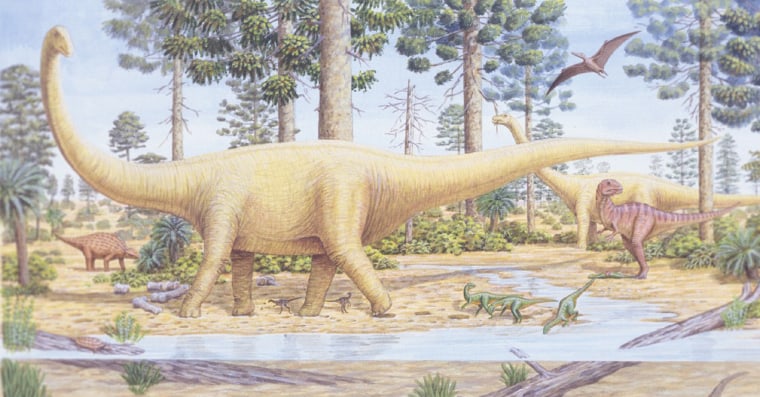Think of a dinosaur and what may come to mind is a large, lumbering animal with four legs, a long neck, a tiny head and tail.
Now a new species helps to explain how this iconic dino body shape evolved.
The new dinosaur, Aardonyx celestae, belongs to the Sauropodomorpha, a group that includes the ancestors of sauropods — gigantic, four-legged herbivores — but not the sauropods themselves. The largest animals that ever walked the earth were sauropodomorphs.
The recently documented sauropodomorph, described in the latest Proceedings of the Royal Society B, lived around 200 to 183 million years ago in South Africa and was nearly 30 feet in length.
"It had a rather long, slender neck and a heavy, barrel-shaped body," Adam Yates, lead author of the paper, told Discovery News, adding that the dinosaur also sported a big nose and was cheek-less.
"The teeth were braced on the outside by a sheet of bone that may indicate the animal was a foliage stripper, which in other words means that when feeding, it grabbed large mouthfuls of browse and pulled backwards to strip the leaves from the branches," said Yates, a University of Witwatersrand paleontologist.
After analyzing the remains, Yates and his team determined this new, Early Jurassic dinosaur lies at the very heart of the sauropodomorph to sauropod transition. The creature's physical structure almost appeared to be a blend of the two groups.
Borrowing from its sauropodomorph roots, A. celestae had narrow jaws, which were primitive and unlike the broad, horseshoe-shaped jaws that gave most sauropods more food per bite. The researchers also believe the huge dinosaur walked on two legs.
"The forearm shows the beginnings of features that would later allow sauropods to drop down onto all fours. But these are so poorly developed, it's doubtful they would have functioned this way in the early stage," Yates said.
A. celestae's foot bones reveal that the inside of its feet bore most of its weight, "a feature called entaxony that is seen in sauropods," he explained.
Since many early sauropods have been excavated in South Africa, the researchers think it's possible this dinosaur clade may have emerged on the part of prehistoric supercontinent Gondwana that is now South Africa.
The iconic sauropod body structure could have evolved when "proto-sauropods began to specialize on bulk-feeding of perhaps lower quality browse," Yates said. In other words, these types of dinosaurs evolved by fattening up prehistoric junk food.
"They needed bigger guts to deal with it," he explained, "which in turn slowed them down, making them vulnerable to predation. So they evolved larger size to help protect them, which in turn meant bulk eating, even larger volumes of low-quality food to fill these even larger guts, and so on, until you get to committed bulk-browsing quadrupedal giants like the sauropods."
The largest sauropods weighed over 110 tons with a mass equivalent to 10 full-grown elephants, or more than 1,000 human adults.
To investigate how these dinosaurs maintained such monumental girth, Jurgen Hummel from the Bonn Institute of Animal Sciences created an apparatus that simulated dino digestion.
Hummel and his team determined that sauropods likely consumed ginkgos and numerous other plants, while "widespread, tall, forest-forming trees provided the largest high-browsing sauropods with a widely available and energy-rich source of food."
Yates believes the bones and muscle scars of the new sauropodomorph indicate this hefty plant-eater didn't run for its dinner and instead had a very slow gait.
"Effectively, it was in a lower gear," he said.
